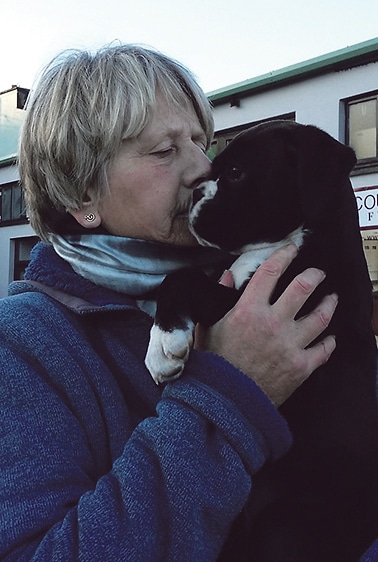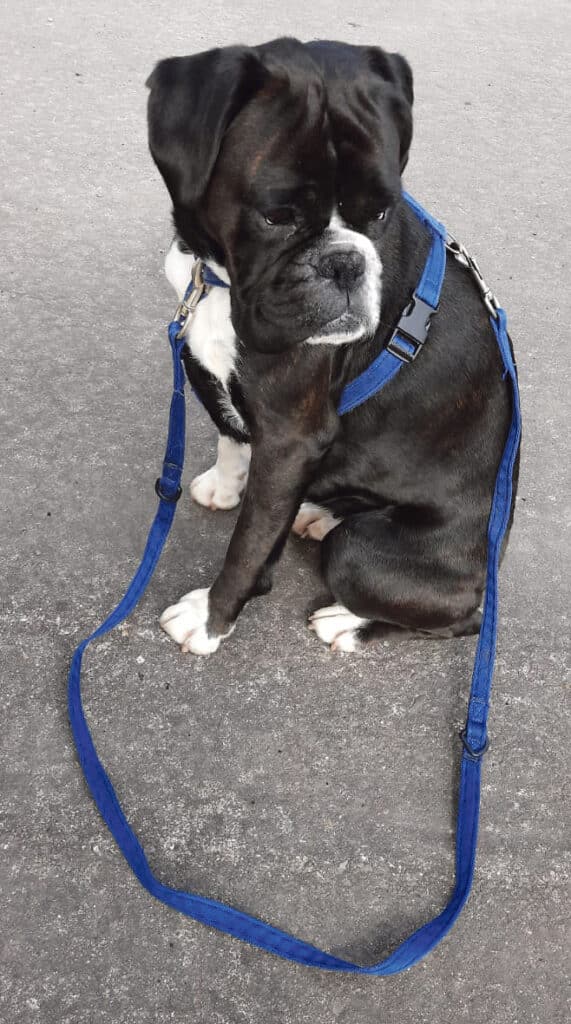
Liz Mahony is an experienced Dog Trainer and Holistic Therapist for all animals. In her monthly column, Liz aims to promote mutual respect between carer and dog. Contact Liz at
corkdogtrainingclasses.com
Last month I talked about getting your dog to focus indoors so that he automatically listens to you outside where the distractions are greater. If you’ve fostered a good training relationship with your dog, he will be happy paying attention to you whenever and wherever.
Start as you mean to go on: That sounds so obvious but it’s a fact that few people have a fixed idea what they want their dog to do out walking. All they can think of is pulling their dog back to their side or yelling ‘No’. There’s nothing positive about that. And you’re not offering your dog an alternative. Your end product should be a dog walking quietly on a loose leash. So keep that in mind. If your dog does his own thing and pulls you every which way, he’s not bothered who’s on the end of his lead. That means he’s still not listening and has neither respect for you nor self-control.

It’s also very important that your dog walks in balance. Pulling and straining from side to side on a collar and lead or a harness that inhibits the dog’s gait can cause or exacerbate skeletal problems especially in dogs that are prone to hip or elbow dysplasia or have weakness in the back.
As you’ll see from the photograph, the double-ended lead attached to the harness that Juno is wearing makes a rein for you to hold. You can hold that ‘rein’ in both hands at the beginning. For example, if your dog is on your right, then your right hand should be on the part of the lead nearest to his back and your left hand towards the front attachment. Hold the lead with your thumbs facing downwards otherwise you’ll be gripping the lead and putting a strain on your arms. And the front part of the lead should always be under the dog’s neck and not over his back. (If you want to walk your dog on the left, then you reverse your hands.)
Counteracting the pull: Ask him to ‘walk on’ but if he begins to pull, you stop while at the same time bending your knees so neither of you gets jerked. Wait until the lead goes a bit slack, then ask him to ‘walk on’. You keep doing that until he gets the message.
Staying grounded: It’s important that you stay relaxed in the face of any distractions. You want to concentrate on keeping your hands soft. If you use the lead as a rein, as described above, it’s much easier to keep them relaxed. However, if you tighten up, you set up tension in yourself and your nervous reaction goes straight down the lead to your dog. He immediately senses that and searches for the cause.
If he sees a person or dog approaching, he may interpret your nervousness as fear of what’s coming. He then may feel he has to protect you and starts to pull, bark, or generally react to make the ‘perceived threat’ go away. That’s how easy it can be to make a dog reactive to people or other dogs. And it started with your tension!
In between stopping, you might even ask him to sit and look at you so you can feed him a treat. That’s keeping the connection between you. It also tells you how your dog is feeling at that moment. If he’s cool, your dog will take the treat in his normal fashion; slightly aroused, he might take it but gulp it down without chewing it. If he’s highly excited or nervous, it’s likely he will take the treat but immediately spit it out or refuse it altogether.
Any of those actions informs you about his state of mind. That’s important. If he’s worked up, then see if there are any outside influences such as people or dogs approaching that are occupying his attention. If he’s bothered by something, then you can make the decision to either walk past it, sit him in a gap to let whatever it is pass or turn back and/or cross the road. If you choose the latter, you’ve made a conscious decision to give your dog the space he needs to process whatever is approaching.
If you do stop to let something pass by at a distance, it’s important that you stay calm. Your dog gets the message that you aren’t concerned by whatever is passing. You want him to take his cue from you.
Having crossed the road, place your dog on the inside so you are in between him and the ‘threat’ and another option is to walk him very fast in either direction. It’s hard for a dog to bark or screech if he’s trotting fast!
In Part 3, I’ll set out further options.


